Cbot-2019-006
RSP 11134
Grower: Research Development Cannabinoid
General Information
- Accession Date
- February 5, 2019
- Reported Plant Sex
- not reported
- Report Type
- StrainSEEK v2 3.2Mb
- DNA Extracted From
- Stem
The strain rarity visualization shows how distant the strain is from the other cultivars in the Kannapedia database. The y-axis represents genetic distance, getting farther as you go up. The width of the visualization at any position along the y-axis shows how many strains there are in the database at that genetic distance. So, a common strain will have a more bottom-heavy shape, while uncommon and rare cultivars will have a visualization that is generally shifted towards the top.
Chemical Information
Cannabinoid and terpenoid information provided by the grower.
Cannabinoids
No information provided.
Terpenoids
No information provided.
Genetic Information
- Plant Type
- Type I
File Downloads
The bell curve in the heterozygosity visualization shows the distribution of heterozygosity levels for cannabis cultivars in the Kannapedia database. The green line shows where this particular strain fits within the distribution. Heterozygosity is associated with heterosis (aka hybrid vigor) but also leads to the production of more variable offspring. When plants have two genetically different parents, heterozygosity levels will be higher than if it has been inbred or backcrossed repeatedly.
The ratio of reads mapped to Y-contigs to reads mapped to the whole Cannabis genome (Y-ratios) has been demonstrated to be strongly correlated with plant sex typing. This plot shows the distribution of Y-ratios for all samples in our database which were sequenced with the same method (panel or WGS) as this sample and where this sample falls in the distribution.
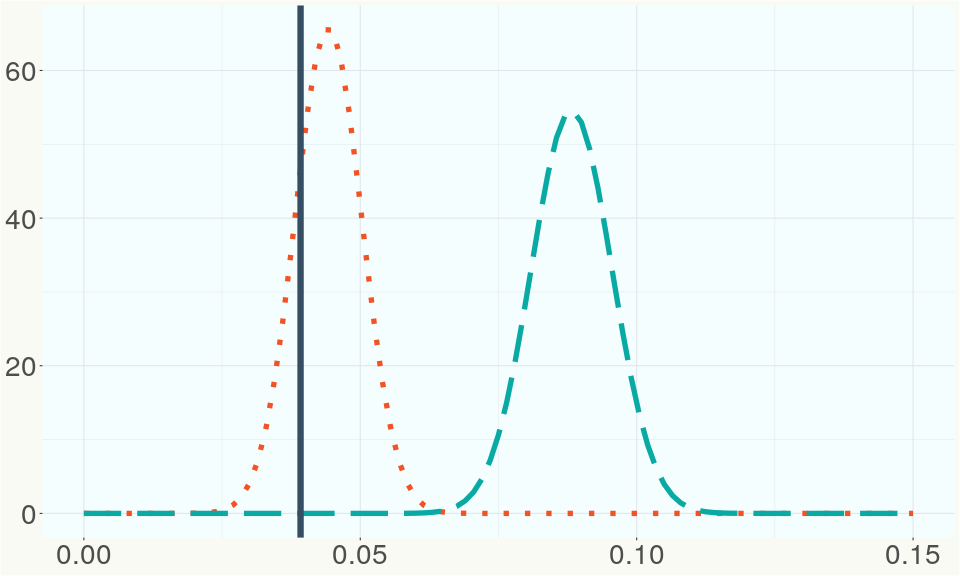
This chart represents the Illumina sequence coverage over the Bt/Bd allele. These are the three regions in the cannabis genome that impact THCA, CBDA, CBGA production. Coverage over the Active CBDAS gene is highly correlated with Type II and Type III plants as described by Etienne de Meijer. Coverage over the THCA gene is highly correlated with Type I and Type II plants but is anti-correlated with Type III plants. Type I plants require coverage over the inactive CBDA loci and no coverage over the Active CBDA gene. Lack of coverage over the Active CBDA and Active THCA allele are presumed to be Type IV plants (CBGA dominant). While deletions of entire THCAS and CBDAS genes are the most common Bt:Bd alleles observed, it is possible to have plants with these genes where functional expression of the enzyme is disrupted by deactivating point mutations (Kojoma et al. 2006).
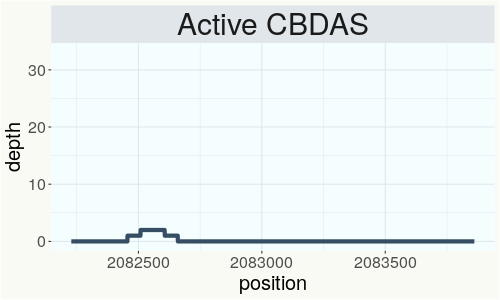
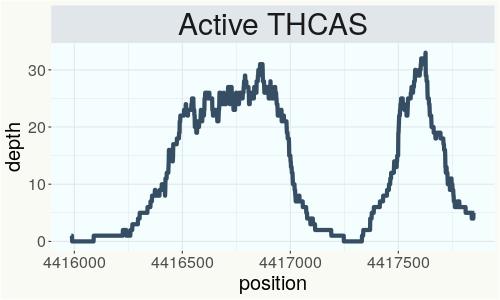
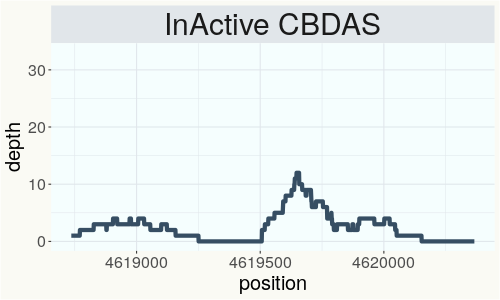
This chart represents the Illumina sequence coverage over the CBCA synthase gene.
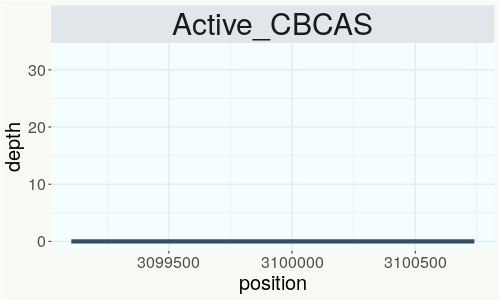
Variants (THCAS, CBDAS, and CBCAS)
No variants to report
Variants (Select Genes of Interest)
| PKSG-2a | c.67T>A | p.Phe23Ile | missense variant | moderate | contig700 | 1945567 | A/T | |
| PKSG-2a | c.31A>T | p.Thr11Ser | missense variant | moderate | contig700 | 1945603 | T/A | |
| PKSG-2b | c.1152T>A | p.Asn384Lys | missense variant | moderate | contig700 | 1950486 | A/T | |
| PKSG-2b | c.1132C>G | p.Leu378Val | missense variant | moderate | contig700 | 1950506 | G/C |
|
| PKSG-2b | c.1117A>G | p.Ile373Val | missense variant | moderate | contig700 | 1950521 | T/C | |
| PKSG-2b | c.948T>G | p.Asp316Glu | missense variant | moderate | contig700 | 1950690 | A/C |
|
| PKSG-2b | c.945T>G | p.Ser315Arg | missense variant | moderate | contig700 | 1950693 | A/C |
|
| PKSG-2b | c.944G>A | p.Ser315Asn | missense variant | moderate | contig700 | 1950694 | C/T |
|
| PKSG-2b | c.934C>G | p.His312Asp | missense variant | moderate | contig700 | 1950704 | G/C |
|
| PKSG-2b | c.31A>T | p.Thr11Ser | missense variant | moderate | contig700 | 1951851 | T/A | |
| PKSG-2b | c.-2_1dupATA | start lost & conservative inframe insertion | high | contig700 | 1951880 | A/ATAT |
|
|
| PKSG-4b | c.496A>G | p.Lys166Glu | missense variant | moderate | contig700 | 2721177 | T/C | |
| PKSG-4b | c.489delT | p.Phe163fs | frameshift variant | high | contig700 | 2721183 | CA/C | |
| PKSG-4b | c.485A>G | p.Lys162Arg | missense variant | moderate | contig700 | 2721188 | T/C | |
| PKSG-4b | c.431T>G | p.Val144Gly | missense variant | moderate | contig700 | 2721242 | A/C | |
| PKSG-4b |
c.352_355del |
p.Thr118fs | frameshift variant | high | contig700 | 2721317 | CCTGT/C |
|
| aPT1 | c.629C>T | p.Thr210Ile | missense variant | moderate | contig121 | 2840237 | C/T | |
| HDS-2 |
c.82_93delGT |
p.Val28_Thr3 |
conservative inframe deletion | moderate | contig95 | 1989748 |
CGTAACCGGAAC |
|
Nearest genetic relatives (All Samples)
- 0.205 Glueberry OG (RSP11222)
- 0.219 RKM-2018-001 (RSP11092)
- 0.220 Liberty Haze (RSP11000)
- 0.222 Domnesia (RSP11184)
- 0.223 Trump x Trump (RSP11466)
- 0.224 CPH (RSP11367)
- 0.234 Golden Goat 2 (RSP10991)
- 0.236 Serious Happiness (RSP10763)
- 0.237 Gold Cracker (RSP11048)
- 0.239 UnObtanium (RSP11611)
- 0.239 Joy (RSP11380)
- 0.243 Liberty Haze (RSP10946)
- 0.244 Recon (RSP10755)
- 0.245 Durban Poison #1 (RSP10996)
- 0.245 Electra (RSP11366)
- 0.247 Gold Cracker (RSP11041)
- 0.249 Big Bud (RSP11221)
- 0.252 RKM-2018-030 (RSP11122)
- 0.252 Blueberry Cheesecake (RSP10684)
- 0.253 Rest (RSP11377)
Most genetically distant strains (All Samples)
- 0.459 Cherry Blossom (RSP11311)
- 0.450 Unknown--Cherry Wine---001- (RSP11268)
- 0.426 Cherry Blossom (RSP11274)
- 0.424 Cherry Blossom (RSP11318)
- 0.420 Unknown--Cherry Wine---002- (RSP11269)
- 0.420 Cherry Blossom (RSP11323)
- 0.419 Cherry Blossom (RSP11306)
- 0.418 Cherry Blossom (RSP11325)
- 0.417 Cherry Blossom (RSP11314)
- 0.416 Cherry Blossom (RSP11317)
- 0.415 Unknown--Cherry Wine---003- (RSP11270)
- 0.412 Cherry Blossom (RSP11328)
- 0.412 Cherry Blossom (RSP11308)
- 0.410 Cherry Blossom (RSP11334)
- 0.410 Unknown--Cherry Wine---004- (RSP11271)
- 0.409 Cherry Blossom (RSP11335)
- 0.409 Tiger Tail -30- (RSP11484)
- 0.407 BagSeed (RSP12627)
- 0.407 Cherry Blossom (RSP11326)
- 0.407 Cherry Blossom (RSP11324)
Nearest genetic relative in Phylos dataset
- Overlapping SNPs:
- 114
- Concordance:
- 76
Nearest genetic relative in Lynch dataset
- Overlapping SNPs:
- 10
- Concordance:
- 8
Blockchain Registration Information
- Transaction ID
-
5535236153dd1e3c
9655467bea1e08a7 b07248bb47b1ce68 2cf139e5ddccf688 - Stamping Certificate
- Download PDF (858.0 KB)
- SHASUM Hash
-
e261302f94f0a0a734b0f5b1036ca425 e790a8f8a9434576 7281e9cb2c7b2ad8